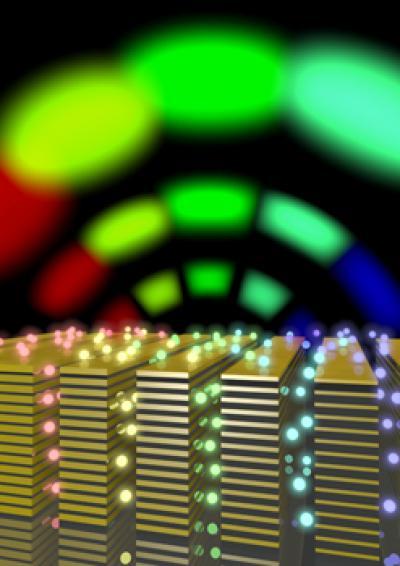A project to develop fast-blinking LED systems for underwater optical communications has led to discovering that an artificial metamaterial can increase the light intensity and "blink speed" of a fluorescent light-emitting dye molecule.
The nanopatterned layers of silver and silicon in the new material sped up the molecule's blink rate to 76 times faster than normal, while producing an 80-fold increase in its brightness.
Extreme blinking speed – ultrafast modulation – in blue and green LEDs is a missing link that is necessary for increasing the rate at which information can be sent via optical channels through the open water, such as between ships and submarines, submarines and divers, underwater environmental sensors and unmanned underwater vehicles, or other combinations.
If dramatically improved, optical wireless communications could eventually replace underwater acoustic communications systems for short distance applications. Acoustic communications are limited by slow speed and low data rates and may possibly cause distress to whales, dolphins and other marine life. To do this, they must develop blue and green LED systems that blink one or two orders of magnitude faster than today's blue and green gallium nitride (GaN) based LEDs.
In underwater optical wireless communications systems, data is converted from an electrical signal to optical waves that travel through the water from a light source such as a LED to an optical receiver. Blinking blue and green LEDs are already used to transfer information through the water. (Blue and green LEDs are used because their light is less apt to be absorbed by the water than other colors.)

This artificial metamaterial can increase the light density and blink speed of a fluorescent light-emitting dye molecule. Image: Liu Research Group/UC San Diego
The metamaterials developed by the researchers are synthetic, with properties not found in nature, and are specially designed to accelerate the light generation process.
"The major purpose of this program is to develop a better light source for communication purposes," said
University of California, San Diego electrical engineering professor Zhaowei Liu. "But this is just a first step in the whole story. We have proved that this artificial, manmade material can be designed to enhance light emission and intensity, but the next step will be to apply this on conventional LEDs."
So far, it's been difficult to directly convert an electrical signal into an optical signal in LEDs with adequate speed. At the moment, the blink rate for most of these converted signals is less than one gigahertz, a rate slower than the speed of most WiFi signals, Liu said.
The materials are designed to have extremely strong interactions with the light emitters that are specific to the wavelength--or color--of the emissions. In the new report, the researchers used a dye molecule that gives off a yellow-green hue. So the next step will be to pair the materials with the blue and green LEDs.
"The design of the materials may not be the hardest thing," said UC San Diego graduate student Dylan Lu, the lead author of the Nature Nanotechnology paper, who noted that they will work with LEDs that have been manufactured to a specific industry standard. "I think the major challenge, to apply it to LEDs, will be an integration issue."
Liu recently won a grant from the Office of Naval Research (ONR) to develop the fast-blinking blue and green LED systems, which includes a little more than $500,000 over three years.
Along with Electrical and Computer Engineering professors Paul Yu and Eric Fullerton, Liu aims to eventually test ultrafast blinking LED configurations in San Diego's ocean waters.
"We started from advances in fundamental material research, and we want to transfer the knowledge to the LED business," said Liu.
Published in Nature Nanotechnology. Source: University of California - San Diego


